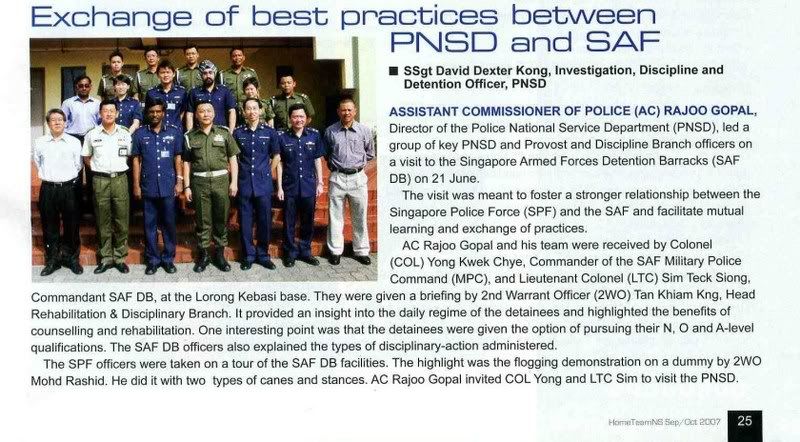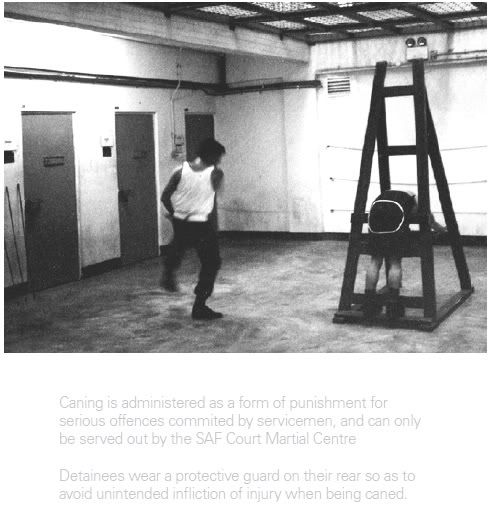Army life is meant to be tough and strenuous, and in many of the world's armed forces, officers are not usually too squeamish about using a bit of ad hoc physical force on recalcitrant squaddies. But the Singapore military is the only one we know of where formal corporal punishment is still part of the official disciplinary regime.
Caning may be imposed on male members of the armed services for a variety of offences under the Singapore Armed Forces Act 1972 as amended in 1975. These include non-compliance with lawful orders, insubordinate behaviour, disobedience of lawful orders, absence without leave, desertion, and escape and permitting escape and unlawful release from custody. The sentence of caning is imposed by a subordinate military court, which may award a maximum of 12 strokes for each offence, with a maximum of 24 strokes at any one court martial. This sentence must be confirmed by the Armed Forces Council.
For offences by servicemen while detained in a disciplinary barracks, a court martial is not necessary. Caning may be ordered by the officer in charge of the disciplinary barracks, but still has to be approved by the Armed Forces Council.
Caning under this regime is less severe than JCP under the Criminal Procedure Code. The cane is supposed to be 6.35mm (a quarter of an inch) in diameter - section 125(4). That is only half the thickness of the adult JCP rattan. This seems unduly thin -- thinner even than many school canes -- and might be a drafting or conversion error. Certainly the canes in the picture at the top of this page look to be considerably thicker than that.
Strangely, the regulations do not stipulate a length for the military cane; it appears in the above picture to be about 4ft (1.2 m), the same as the judicial one.
Paragraph 26 of the Singapore Armed Forces (Disciplinary Barracks) Regulations  stipulates that the person to be caned "is to wear protective clothing to prevent as far as possible any permanent scar, cutting of the skin or bleeding from being caused by the caning".
stipulates that the person to be caned "is to wear protective clothing to prevent as far as possible any permanent scar, cutting of the skin or bleeding from being caused by the caning".
The picture shows the "protective guard" covering the offender's posterior during the punishment. It is not clear what it is made of, or why this is thought better than simply having him wear a pair of shorts. Presumably it is of some fabric or other, and not too thick, otherwise little pain would be transmitted and the exercise would be pointless.
The Disciplinary Barracks Regulations specify at section 26(3):
Where a sentence of caning is awarded under section 118 (15) or 119 of the Act, the caning shall be inflicted on the buttocks of the persons on whom such sentence is awarded.
We can see that the A-frame or trestle used is exactly the same as for judicial canings (see these pictures).
Also as with judicial caning, a doctor must be present and certify that the offender is fit to be caned. But in the military version, the rules also state that the medical officer "shall, upon the completion of every stroke, examine the detainee or military prisoner to determine his suitability to continue with the punishment" (Singapore Armed Forces (Detention and Imprisonment) Regulations, s.47(5). This is not required in the caning of civilians in ordinary prisons.
Military service is compulsory for all males in Singapore. The original rationale for the imposition of caning was that existing penalties were insufficient for some National Servicemen. These are conscripts, generally in their teens. Corporal punishment was seen to be necessary to control the more incorrigible amongst them. In the 1975 debate in Parliament when this legislation was amended, the Defence Minister stressed that the caning "will not be of the kind administered to hardened criminals", and noted that the offender in such cases was "usually a poorly educated teenage national serviceman". National service, he pointed out, covers "all strata of society, including those of low education and intelligence", and experience had shown that CP was necessary because deserters, AWOLs and other "incorrigible offenders" from this group had not been sufficiently deterred by existing forms of punishment.
Nevertheless, it is not only conscripts who are liable to be caned.
Many of the offences punishable by caning seem relatively trivial in nature, and some of them, such as "insubordinate behaviour", might encompass a wide spectrum of activities.

The SAF Detention Barracks in Kranji, where canings are (or were) administered
The legislation explicitly provides for boy soldiers under 16 to be caned, in which case the maximum punishment at any one trial is ten strokes instead of 24. This clause is still in force, but must be a dead letter, since 16½ is now the minimum age for enlistment. The normal age for starting national service is currently 18 and it lasts two years.
It is not known how often this military punishment is actually used. Such matters are not often reported. Anecdotal reports suggest that the caning provisions are now little used in practice, although uncorroborated local sources do indicate that a 20-year-old conscript was caned in the SAF Detention Barracks in May 2013. Nevertheless, the relevant legislation remains in force in 2022, and it is understood that the necessary equipment is still in place.
One case that did get reported is that of a 23-year-old Lance-Corporal, sentenced in Jan 2009 by a court-martial to a six-stroke caning plus three years in jail, for his part in beating up a 19-year-old conscript.
That this kind of punishment was still current at least in 2007 is also suggested by the following extract from HomeTeamNS (Sep/Oct 2007), an internal magazine for national servicemen. It reports that police officers visiting the SAF Detention Barracks were treated to a flogging demonstration on a dummy, using "two types of cane and stances". It seems unlikely that this event would have been arranged if CP was never administered.

Section 3 defines the persons subject to the Act as including all civilians who are in the service of the Singapore Armed Forces when engaged on active service or who are followers of, or accompany, the Singapore Armed Forces when engaged on active service, and officers and soldiers belonging to a Commonwealth or foreign force when attached to or seconded for service with or otherwise acting as part of or with any portion of the Singapore Armed Forces.
This seems to imply that foreign troops posted to Singapore might be liable to caning for such offences as "insubordinate behaviour" and "disobedience of general orders".
In practice, the only known canings of visiting foreign military personnel were ordered not under these provisions but under the ordinary civilian law. An example was the case of two young New Zealand soldiers sentenced to caning in 1981 (3 strokes each for drug offences). (New Zealand is one of the countries with which Singapore has a joint defence agreement.) It appears from this report that the NZ military authorities gladly handed their two lads over to the Singapore courts because they actually wanted them caned in order to make an example of them. Corporal punishment would not have been available had their request to be tried by an NZ military court martial been granted.


